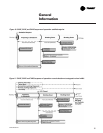
CVHE-SVU01E-EN
18
General
Information
Base Loading Control
Algorithm:
This feature allows an external
controller to directly modulate the
capacity of the chiller. It is typically
used in applications where virtually
infinite sources of evaporator load
and condenser capacity are available
and it is desirable to control the
loading of the chiller. Two examples
are industrial process applications
and cogeneration plants. Industrial
process applications might use this
feature to impose a specific load on
the facility’s elecrical system.
Cogeneration plants might use this
feature to balance the system’s
heating, cooling and electrical
generation.
All chiller safeties and adaptive
control functions are in full effect
when Base Loading control is
enabled. If the chiller approaches full
current, the evaporator temperature
drops too low, or the condenser
pressure rises too high, Tracer CH530
Adaptive Control logic limits the
loading of the chiller to prevent the
chiller from shutting down on a
safety limit. These limits may prevent
the chiller from reaching the load
requested by the Base Loading
signal.
Base Loading Control is basically a
variation of the current limit
algorithm. During base loading, the
leaving water control algorithm
provides a load command every 5
seconds. The current limit routine
may limit the loading when the
current is below setpoint. When the
current is within the deadband of the
setpoint the current limit algorithm
holds against this loading command.
If the current exceeds the setpoint,
the current limit algorithm unloads.
The “Capacity Limited By High
Current” message normally
displayed while the current limit
routine is active is suppressed while
base loading.
Base loading can occur via Tracer,
External signal, or front panel.
Tracer Base Loading:
Current Setpoint Range:
(20 - 100) percent RLA
Requires Tracer and Optional Tracer
Communications Module (LLID)
The Tracer commands the chiller to
enter the base load mode by sending
the base load mode request. If the
chiller is not running, it will start
regardless of the differential to start
(either chilled water or hot water). If
the chiller is already running, it will
continue to run regardless of the
differential to stop (either chilled
water or hot water), using the base
load control algorithm. While the unit
is running in base loading, it will
report that status back to the Tracer
by setting “Base Load Status = true”
in the Tracer Status Byte. When the
Tracer removes the base load mode
request (sets the bit to 0). The unit
will continue to run, using the
normal chilled or hot water control
algorithm, and will turn off, only
when the differential to stop has been
satisfied.
External Base Loading:
Current Setpoint Range:
(20 - 100) percent RLA
The UCP accepts 2 inputs to work
with external base loading. The
binary input is at 1A18 Terminals J2-1
and J2-2 (Ground) which acts as a
switch closure input to enter the
base-loading mode. The second
input, an analog input, is at 1A17
terminals J2 – 1 and 3 (Ground)
which sets the external base loading
setpoint, and can be controlled by
either a 2-10Vdc or 4-20ma Signal. At
startup the input type is configured.
The graphs in Figure 13 show the
relationship between input and
percent RLA. While in base loading
the active current limit setpoint is set
to the Tracer or external base load
setpoint, providing that the base load
setpoint is not equal to 0 (or out of
range). If it is out of range, the front
panel current limit setpoint is used.
During base loading, all limits are
enforced with the exception of
current limit. The human interface
displays the message “Unit is
Running Base Loaded”. Hot Gas
Bypass is not run during base
loading. If base loading and ice
making are commanded
simultaneously, ice making takes
precedence.
An alternative and less radical
approach to Base Loading indirectly
controls chiller capacity. Artifically
load the chiller by setting the chilled
water setpoint lower than it is
capable of achieving. Then, modify
the chiller’s load by adjusting the
current limit setpoint. This method
provides greater safety and control
stability in the operation of the chiller
because it has the advantage of
leaving the chilled water temperature
control logic in effect. The chilled
water temperature control logic
responds quicker to dramatic system
changes, and can limit the chiller
loading prior to reaching an Adaptive
Control limit point.


















